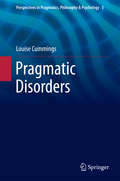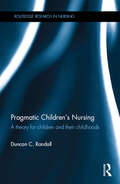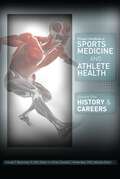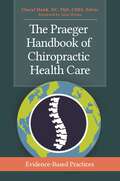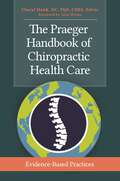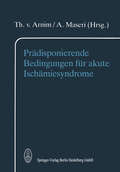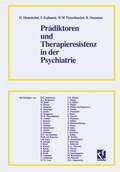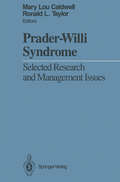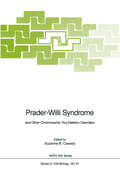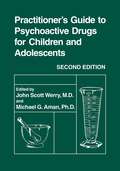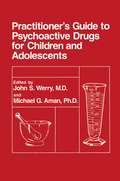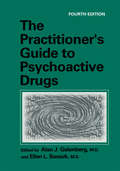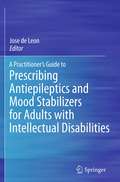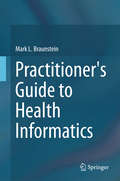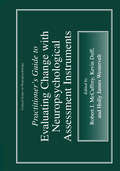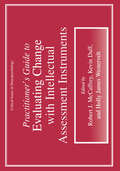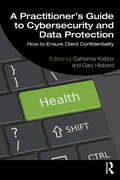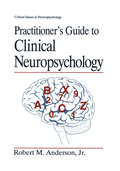- Table View
- List View
Pragmatic Disorders: A Workbook (Perspectives in Pragmatics, Philosophy & Psychology #3)
by Louise CummingsThis wide-ranging survey of the state of the art in clinical pragmatics includes an examination of pragmatic disorders in previously neglected populations such as juvenile offenders, children and adults with emotional and behavioural disorders, and adults with non-Alzheimer dementias. This book makes a significant contribution to the discussion of pragmatic disorders by exploring topics which have a fast-rising profile in the field. These topics include disorders in which there are both pragmatic and cognitive components, and studies of the complex impacts of pragmatic disorders such as mental health problems, educational disadvantage and social exclusion. This book also presents a critical evaluation of our current state of knowledge of pragmatic disorders. The author focuses on the lack of integration between theoretical and clinical branches of pragmatics and argues that the work of clinicians is all too often inadequately informed by theoretical frameworks. She attempts to bridge these gaps by pursuing a closer alliance of clinical and theoretical branches of pragmatics. It is claimed that this alliance represents the most promising route for the future development of the field. At once a yardstick measuring progress thus far in clinical pragmatics, and also a roadmap for future research development, this single-author volume defines where we have reached in the field, as well as where we have to go next.
Pragmatic Children's Nursing: A Theory for Children and their Childhoods (Routledge Research in Nursing and Midwifery)
by Duncan C. RandallPragmatic Children’s Nursing is the first attempt to create a paediatric nursing theory which argues for the importance of giving children living with illness access to a childhood which is, as far as possible, equal to that of their peers. Set in the historical context of the development of children’s nursing, this theory is presented in detail as an educational process, complete with eight outcome measures which allow the practitioner to evaluate its effectiveness. This book explores the triad relationship between children, carers and nurses within the context of healthcare delivery. Ht analyses the moral and ethical implications of pragmatic children’s nursing, which challenges the established ideas of family-centred care. In addition to offering theoretical grounding and debate, Randall presents four practical case studies which model how this theory may work within various hospital and community settings. Establishing a link between the concepts inherent in pragmatism and our understanding of childhood within society, this accessible book will appeal to a global audience of undergraduate and postgraduate nursing students, researchers and policy makers. Discover more about this subject on our author Duncan C. Randall's website, which provides extra resources and information here: http://pragmaticchildrensnursing.com/
Pragmatic Children's Nursing: A Theory for Children and their Childhoods (Routledge Research in Nursing and Midwifery)
by Duncan C. RandallPragmatic Children’s Nursing is the first attempt to create a paediatric nursing theory which argues for the importance of giving children living with illness access to a childhood which is, as far as possible, equal to that of their peers. Set in the historical context of the development of children’s nursing, this theory is presented in detail as an educational process, complete with eight outcome measures which allow the practitioner to evaluate its effectiveness. This book explores the triad relationship between children, carers and nurses within the context of healthcare delivery. Ht analyses the moral and ethical implications of pragmatic children’s nursing, which challenges the established ideas of family-centred care. In addition to offering theoretical grounding and debate, Randall presents four practical case studies which model how this theory may work within various hospital and community settings. Establishing a link between the concepts inherent in pragmatism and our understanding of childhood within society, this accessible book will appeal to a global audience of undergraduate and postgraduate nursing students, researchers and policy makers. Discover more about this subject on our author Duncan C. Randall's website, which provides extra resources and information here: http://pragmaticchildrensnursing.com/
Praeger Handbook of Sports Medicine and Athlete Health [3 volumes]: [Three Volumes] [3 volumes]
by Claude T. Moorman Donald T. Kirkendall Ruben J. EchemendiaThis comprehensive set covers every aspect of sports medicine, from how to play healthy to how to pursue a career in this varied field.The groundbreaking, three-volume Praeger Handbook of Sports Medicine and Athlete Health introduces readers to sports medicine and explains what we can do to prevent or recover from sports injuries—of body or mind. The astoundingly comprehensive set is chock full of everything anyone would want to know about the subject, from how to pursue a career in sports medicine to how to understand, treat, and avoid various injuries and psychological problems that may arise from participation. Volume 1, Sports Medicine History, Careers offers personal descriptions of the career path of professionals in sports medicine, covering virtually all of the numerous specialties. Volume 2, Athlete Health, Injuries, and Prevention is focused around specific injury locations with accessibly written descriptions of the anatomical location, how injuries happen, and how the injury is treated. Volume 3, Athlete Mental Health serves as a broad survey and discussion of everything from teamwork to performance anxiety, body-image distortion, family pressures, and issues associated with aging.
The Praeger Handbook of Chiropractic Health Care: Evidence-Based Practices
by Cheryl HawkWhat does scientific research show about the effectiveness of chiropractic care? How are chiropractors trained and what do they do? When should one turn to chiropractic care, and how does one select a practitioner? This book answers all of these questions and more.Chiropractic is the most frequently used complementary and alternative medicine (CAM) practice in the United States, with nearly $4 billion spent out-of-pocket annually by chiropractic patients. In fact, as evidence for its effectiveness for common conditions such as back pain continues to mount and acceptance grows in a variety of health care settings, chiropractic could be considered more "mainstream" than many other forms of CAM. In this information-packed single-volume work, an expert team led by Cheryl Hawk—a well-known chiropractic researcher—explains chiropractic licensure, practice, and effectiveness to general readers researching chiropractic care options and to undergraduate students choosing a major or specialty. Readers will see the range of scientific evidence supporting the use of chiropractic health care for many common conditions, learn about the typical chiropractic clinical encounter and chiropractic procedures, and understand the criteria by which patients and other health professionals can use to select a chiropractic physician. This book also provides health care practitioners in other fields with current information that enables a greater understanding of the training and the roles of chiropractors in health care.
The Praeger Handbook of Chiropractic Health Care: Evidence-Based Practices
by Cheryl HawkWhat does scientific research show about the effectiveness of chiropractic care? How are chiropractors trained and what do they do? When should one turn to chiropractic care, and how does one select a practitioner? This book answers all of these questions and more.Chiropractic is the most frequently used complementary and alternative medicine (CAM) practice in the United States, with nearly $4 billion spent out-of-pocket annually by chiropractic patients. In fact, as evidence for its effectiveness for common conditions such as back pain continues to mount and acceptance grows in a variety of health care settings, chiropractic could be considered more "mainstream" than many other forms of CAM. In this information-packed single-volume work, an expert team led by Cheryl Hawk—a well-known chiropractic researcher—explains chiropractic licensure, practice, and effectiveness to general readers researching chiropractic care options and to undergraduate students choosing a major or specialty. Readers will see the range of scientific evidence supporting the use of chiropractic health care for many common conditions, learn about the typical chiropractic clinical encounter and chiropractic procedures, and understand the criteria by which patients and other health professionals can use to select a chiropractic physician. This book also provides health care practitioners in other fields with current information that enables a greater understanding of the training and the roles of chiropractors in health care.
Prädisponierende Bedingungen für akute Ischämiesyndrome
by T. Von Arnim A. MaseriDer vorliegende Band "Prädisponierende Bedingungen flir akute Ischämiesyn drome" faßt die Ergebnisse eines internationalen Symposiums zusammen, das am 14. und 15. Oktober 1988 in Garmisch-Partenkirchen stattfand. Die Herausgeber dieses Buches danken den Autoren herzlich flir ihre Bemühungen, die Manuskripte bereits vor dem Treffen fertigzustellen, der Bayer AG flir ihre großzügige Unter stützung und dem Verlag flir die effiziente Zusammenarbeit. All diese Teilanstren gungen haben gemeinsam das rasche Erscheinen dieses Bandes ermöglicht. Bei der koronaren Herzkrankheit wird die Prognose flir die Patienten weitgehend durch den Eintritt einer irreversiblen ischämischen Schädigung des Herzmuskels bestimmt. Den irreversiblen Ereignissen geht eine Destabilisierung eines zuvor sta bilen Zustandes voraus. Diese Destabilisierung kann mit sich verstärkender Sym ptomiltik oder ohne sichtbare Warnzeichen flir Patient und Arzt eintreten; sie kann über einen längeren Zeitraum oder sehr rasch ablaufen. Dennoch trifft die Aussage zu, daß kein Patient jemals an einer stabilen Angina pectoris verstorben ist. Also muß man sich, will man die Prognose flir die Patienten mit koronarer Herzkrankheit verbessern, auf das Erkennen und die Behandlung der instabilen Ischämiesyndrome konzentrieren. Ziel des Symposiums war es, Wissenschaftler und Kliniker aus verschiedenen Forschungsgebieten zusammenzuführen, um zu einem aktuellen Überblick über die unterschiedlichen Aspekte der instabilen Ischämiesyndrome zu gelangen und die interdisziplinäre Diskussion zu fOrdern.
Prader-Willi Syndrome: Selected Research and Management Issues
by Mary L. Caldwell Ronald L. TaylorPrader-Willi Syndrome: Selected Research and Management Issues investigates the most recent developments in the diagnosis and management of individuals with the syndrome. This volume is not intended as a comprehensive review, but as a source of new, original research on this little understood syndrome. Alternative methods of identification and treatment are considered, and issues related to the nonmedical characteristics are explored.
Prader-Willi Syndrome: and Other Chromosome 15q Deletion Disorders (Nato ASI Subseries H: #61)
by Suzanne B. CassidyAlthough Prader-Willi syndrome was first described 35 years ago, it was following detection of an interstitial chromosome 15q deletion in some affected patients ten years ago that it became a major focus of multidisciplinary scientific interest. This interest was compounded by the later determination that some patients with a clinically distinct disorder, Angelman syndrome, apparently also had the same chromosome 15q deletion. Subsequently, molecular genetic studies showed that some cytogenetically normal patients with both disorders have uniparental disomy, maternal in Prader-Willi syndrome and paternal in Angelman syndrome. Genetic imprinting has been implicated in this unusual phenomenon. This Workshop was conceived to bring together clinical and basic scientists from around the world whose research was focused on unraveling this unique genetic situation and further delineating these two fascinating disorders. As this volume demonstrates, it was successful in reaching this goal. Laboratory and clinical scientists from 15 countries in four continents participated, and even more countries were represented among the professional and parent observers of its proceedings. Many participants had previously known each other in print only. As a consequence of the Workshop, conclusions could be drawn on several issues. International collaborative research efforts were established. And acquaintances were developed between people who investigate the genetics of these disorders from differing perspectives, resulting in enrichment of approach to answering the complex questions posed by these fascinating conditions. Plans were initiated for another such scientific workshop a few years hence. This volume includes papers presented from the platform.
Practitioner’s Guide to Psychoactive Drugs for Children and Adolescents
by Michael G. Aman John ScottWerryIncorporating the latest developments in pharmacology and therapy, this fully revised Second Edition is an ideal quick reference for those who prescribe psychotrophic drugs for young people. New and notable features include: discussions of new drugs and health supplements; revised diagnostic terminology that accords with current DSM-IV nomenclature; reports on anti-epileptic medications; guidelines for the appropriate use of psychoactive medications; and instruction on the monitoring of physical, behavioral, and cognitive effects of various drugs. The handy spiral format makes the book easy to use.
Practitioner’s Guide to Psychoactive Drugs for Children and Adolescents
by John S. Werry Michael G. Amaninformation. This book aims to do this for practitioners, professionals in health, welfare, and education, and interested laypersons, including parents. This is no easy task, since the levels of technical knowledge vary from that of the special education teacher seeking information about the drugs that many such pupils will be receiving, to that of the modern young child and adolescent psychiatrist whose grasp of the difficult fields of pharmacokinetics (how drugs are absorbed, distributed, and eliminated) and neurotransmitter physiology (via which most psychoactive drugs work) is daunting to the editors, who grew up in the bucolic clinical-empirical era. Inevitably there are sections of the book that will prove too technical for any except the medically qualified, but considerable effort has been applied to make much of the text, especially that discussing the clinical uses and side effects of the drugs, comprehensible to anyone used to getting information by reading. We also take comfort in the fact that many of the major contributions in pediatric psychophar macology have been made by nonmedical professionals, notably psychologists, suggesting that an audience beyond the medically qualified is practicable. One other problem confronted us-whether to organize the book by psycho pathological symptoms (e.g., hyperactivity) and disorders (e.g., autism) or by drugs.
The Practitioner’s Guide to Psychoactive Drugs (Topics In General Psychiatry Ser.)
by Alan J. Gelenberg Ellen L. BassukOnce again, in their new edition of a classic American handbook of clinical psycho pharmacology, Drs. Gelenberg and Bassuk and their colleagues have produced a master work of sound clinical guidelines for the use of medicines as an increasingly central component of contemporary psychiatric practice. They have recruited an outstanding panel of coauthors, but have managed to maintain a high level of consistency of quality and style throughout the many chapters on specific classes of psychiatric illnesses and their corresponding treatments. The book continues to encapsulate the clinically rele vant essentials of the pharmacology of each major class of psychotropic agents in a way that clinicians can easily grasp. Moreover, it provides sound and carefully consid ered specific guidelines to diagnosis, drug selection, and dosing and patient assessment, with particularly rich presentations on the recognition and management of adverse effects. Inclusion of chapters on pediatric and geriatric populations and on topics pertaining to substance abuse disorders and medicolegal aspects of the field are unusual in books of this kind, and so are particularly valuable. Students and trainees will appreciate the handbook's well-organized and readable style, and practicing clinicans should be satisified with its balanced consideration of older, standard treatments as well as the latest medicines and trends in clinical psychopharmacology, with glimpses into future developments.
A Practitioner's Guide to Prescribing Antiepileptics and Mood Stabilizers for Adults with Intellectual Disabilities
by Jose LeonEmotional, behavioral, and neuropsychiatric conditions are common in individuals with intellectual disabilities (IDs), most notably epilepsy, aggression, self-injurious behaviors, and bipolar and other mood disorders. Despite the prevalence of such problems, there is a scarcity in the literature of reliable information on medical treatments for those with IDs.A Practitioner's Guide to Prescribing Antiepileptics and Mood Stabilizers for Adults with Intellectual Disabilities provides a detailed framework for prescribing for this challenging population. Featuring the most up-to-date information on factors that inform prescribing, the Guide addresses basic issues and controversies (e.g., the rift between evidence-based and personalized medicine) in treating adults with cognitive deficits. Clients' specific needs are emphasized in developing appropriate and effective pharmacological intervention for improved outcomes and quality of life. Drugs discussed in the Guide include carbamazepine, clonazepam, diazepam, ethosuximide, felbamate, gabapentin, lacosamide, lamotrigine, levetiracetam, lithium, lorazepam, oxcarbazepine, phenobarbital, phenytoin, pregabalin, primidone, rufinamide, tiagabine, topiramate, valproate, and zonisamide. For each of these compounds, the guidelines cover:Indications for use; relative and absolute contraindications.Assessment during treatment; therapeutic drug monitoring; warning signs and symptoms for caretakers.Dosage: administration; initial and maximum recommended dosage; modifications associated with drug-drug interactions, personal characteristics, and (where appropriate) genetic variations.Adverse drug reactions: common, relatively uncommon, and potentially lethal, plus risk of metabolic syndrome.Guidelines for discontinuation.References, tables, and drug utilization reviews.A Practitioner's Guide to Prescribing Antiepileptics and Mood Stabilizers for Adults with Intellectual Disabilities is an indispensable decision-making reference for psychiatrists, neuropsychologists, psychopharmacologists, neurologists, internists, and clinical psychologists.
Practitioner's Guide to Health Informatics
by Mark L. Braunstein"This book will be a terrific introduction to the field of clinical IT and clinical informatics" -- Kevin Johnson"Dr. Braunstein has done a wonderful job of exploring a number of key trends in technology in the context of the transformations that are occurring in our health care system" -- Bob Greenes"This insightful book is a perfect primer for technologists entering the health tech field." -- Deb Estrin"This book should be read by everyone." -- David KibbeThis book provides care providers and other non-technical readers with a broad, practical overview of the changing US healthcare system and the contemporary health informatics systems and tools that are increasingly critical to its new financial and clinical care paradigms. US healthcare delivery is dramatically transforming and informatics is at the center of the changes. Increasingly care providers must be skilled users of informatics tools to meet federal mandates and succeed under value-based contracts that demand higher quality and increased patient satisfaction but at lower cost. Yet, most have little formal training in these systems and technologies. Providers face system selection issues with little unbiased and insightful information to guide them. Patient engagement to promote wellness, prevention and improved outcomes is a requirement of Meaningful Use Stage 2 and is increasingly supported by mobile devices, apps, sensors and other technologies. Care providers need to provide guidance and advice to their patients and know how to incorporated as they generate into their care. The one-patient-at-a-time care model is being rapidly supplemented by new team-, population- and public health-based models of care. As digital data becomes ubiquitous, medicine is changing as research based on that data reveals new methods for earlier diagnosis, improved treatment and disease management and prevention. This book is clearly written, up-to-date and uses real world examples extensively to explain the tools and technologies and illustrate their practical role and potential impact on providers, patients, researchers, and society as a whole.
Practitioner’s Guide to Evaluating Change with Neuropsychological Assessment Instruments (Critical Issues in Neuropsychology)
by Robert J. McCaffrey Kevin Duff Holly James WesterveltThe impetus for this volume began with our research in the 1980's involving serial neuropsychological evaluation with various patient populations. At that time, reports on the practice effects associated with routinely utilized clinical neuropsychological instruments were sparse. While test-retest data were available for almost all assessment instruments, this was usually in the form of correlation coefficients and not changes in mean performance between or across assessment periods (see McCaffrey & Westervelt, 1995 for a detailed discussion of these and related issues). Clinical neuropsychological practitioners had few guidelines to assist them in determining if a change in a patient's performance across assessments was due to an intervention, maturation, practice effects, or a combination of factors. This volume represents our efforts at reviewing the literature between 1970 and 1998 and extracting the reported information on practice effects. The tables include the assessment instrument used, information on the subject/patient groups, the sample size (n}, gender, age, intervention, interval between the assessments, scores at both assessment points, and the citation. Those studies that reported data on more than two assessment points are indicated by a notation~ however, any data beyond the second assessment are not reported and the interested reader should refer to the original article. The tables are arranged alphabetically for the most widely used assessment instruments. Those instruments for which there was limited data on practice effects are grouped by "domain" (e. g.
Practitioner’s Guide to Evaluating Change with Intellectual Assessment Instruments (Critical Issues in Neuropsychology)
by Kevin DuffWhile conducting research on intellectual and neuropsychological perfonnance of various patient populations across time, we became aware of the lack of information concerning practice effects associated with many widely used assessment instruments. Although test-retest data were available for almost all of these instruments, it typically came in the form of correlation coefficients and mean changes in performance between assessments was often absent. In a 1995 article (McCaffrey & Westervelt, 1995), we discussed a number of issues relevant to serial neuropsychological and intellectual assessment and concluded that clinical neuropsychological practitioners had few guidelines to assist them in interpreting change in a patient's performance across assessments. This volume represents our efforts at reviewing the literature between 1970 and 1998 and extracting the reported information on practice effects. The tables include the assessment instrument used, information on the subject/patient groups, the sample size fu}, gender, age, intervention, interval between the assessments, scores at both assessment points, and the citation. The tables reflect the existing published literature within intellectual assessment and, therefore, some instruments (e.g., Wechsler tests) comprise a majority of the tables whereas others (e.g., Raven's Progressive Matrices, Stanford-Binet) do not. The test index is arranged by the name of the test as reported in the specific article. We caution readers to refer to the original articles if additional or more specific information is needed.
Practitioner's Guide to Ethics and Mindfulness-Based Interventions (Mindfulness in Behavioral Health)
by Lynette M. Monteiro Jane F. Compson Frank MustenThis book focuses on the role of ethics in the application of mindfulness-based interventions (MBIs) and mindfulness-based programs (MBPs) in clinical practice. The book offers an overview of the role of ethics in the cultivation of mindfulness and explores the way in which ethics have been embedded in the curriculum of MBIs and MBPs. Chapters review current training processes and examines the issues around incorporating ethics into MBIs and MBPs detailed for non-secular audiences, including training clinicians, developing program curriculum, and dealing with specific client populations. Chapters also examine new, second-generation MBIs and MBPs, the result of the call for more advanced mindfulness-based practices . The book addresses the increasing popularity of mindfulness in therapeutic interventions, but stresses that it remains a new treatment methodology and in order to achieve best practice status, mindfulness interventions must offer a clear understanding of their potential and limits.Topics featured in this book include:• Transparency in mindfulness programs.• Teaching ethics and mindfulness to physicians and healthcare professionals. • The Mindfulness-Based Symptom Management (MBSM) program and its use in treating mental health issues.• The efficacy and ethical considerations of teaching mindfulness in businesses. • The Mindful Self-Compassion (MSC) Program. • The application of mindfulness in the military context. Practitioner’s Guide to Mindfulness and Ethics is a must-have resource for clinical psychologists and affiliated medical, and mental health professionals, including specialists in complementary and alternative medicine and psychiatry. Social workers considering or already using mindfulness in practice will also find it highly useful.
Practitioner's Guide to Empirically-Based Measures of Depression (ABCT Clinical Assessment Series)
by Arthur M. NezuThis book is intended to guide clinicians and researchers in choosing practical tools relevant for clinical assessment, intervention, and/or research in this area. It contains over 90 reviews of measures of depression and depression-related constructs. It provides summary tables comparing and contrasting different instruments in terms of their time requirements, suitability, costs, administration, reliability, and validity, and sample copies of 25 instruments in the public domain.
Practitioner's Guide to Empirically Based Measures of Anxiety (ABCT Clinical Assessment Series)
by Martin M. Antony Susan M. Orsillo Lizabeth RoemerThis volume provides a single resource that contains information on almost all of the measures that have demonstrated usefulness in measuring the presence and severity of anxiety and related disorders. It includes reviews of more than 200 instruments for measuring anxiety-related constructs in adults. These measures are summarized in `quick view grids' which clinicians will find invaluable. Seventy-five of the most popular instruments are reprinted and a glossary of frequently used terms is provided.
Practitioner's Guide to Developmental and Psychological Testing (Critical Issues in Developmental and Behavioral Pediatrics)
by Glen P. AylwardThe practice of primary health care has expanded beyond the "traditional" medical model. Primary-care physicians and allied professionals are called upon more frequently to address parental concerns about develop mental delays, poor school performance, or behavioral problems. As a result, pediatricians, family practitioners, pediatric nurses, social workers, and speecManguage specialists are faced with the issue of developmental and psychological testing. The degree of the clinician's involvement in testing varies from interpretation of reports to performing screening or assessments. In many cases, the primary health care professional assumes the role of case manager. Unfortunately, cooperation between disciplines often has been lim ited because of poor communication, particularly in regard to develop mental and psychological testing, where acronyms, statistics, and jargon abound. Even professionals from mental health disciplines such as child psychiatrists or psychiatric social workers sometimes are overwhelmed. The purpose of this book, therefore, is to provide the clinician with practical information regarding developmental and psychological testing, thereby making the health care professional an "educated consumer. " This text does not simply describe how psychologists perform testing; rather, it provides information to help clinicians understand what the tests con tain, what their strengths and limitations are, and how they can be incorporated into practice.
A Practitioner’s Guide to Cybersecurity and Data Protection: How to Ensure Client Confidentiality
by Catherine Knibbs Gary HibberdA Practitioner’s Guide to Cybersecurity and Data Protection offers an accessible introduction and practical guidance on the crucial topic of cybersecurity for all those working with clients in the fields of psychology, neuropsychology, psychotherapy, and counselling. With expert insights, it provides essential information in an easy-to-understand way to help professionals ensure they are protecting their clients’ data and confidentiality, and protecting themselves and their patients from cyberattacks and information breaches, along with guidance on ethics, data protection, cybersecurity practice, privacy laws, child protection, and the rights and freedoms of the people the practitioners work with. Explaining online law, privacy, and information governance and data protection that goes beyond the GPDR, it covers key topics including: contracts and consent; setting up and managing safe spaces; children's data rights and freedoms; email and web security; and considerations for working with other organisations. Illustrated with examples from peer-reviewed research and practice, and with practical ‘top tips’ to help you implement the advice, this practical guide is a must-read for all working-from-home practitioners in clinical psychology, developmental psychology, neuropsychology, counselling, and hypnotherapy.
A Practitioner’s Guide to Cybersecurity and Data Protection: How to Ensure Client Confidentiality
A Practitioner’s Guide to Cybersecurity and Data Protection offers an accessible introduction and practical guidance on the crucial topic of cybersecurity for all those working with clients in the fields of psychology, neuropsychology, psychotherapy, and counselling. With expert insights, it provides essential information in an easy-to-understand way to help professionals ensure they are protecting their clients’ data and confidentiality, and protecting themselves and their patients from cyberattacks and information breaches, along with guidance on ethics, data protection, cybersecurity practice, privacy laws, child protection, and the rights and freedoms of the people the practitioners work with. Explaining online law, privacy, and information governance and data protection that goes beyond the GPDR, it covers key topics including: contracts and consent; setting up and managing safe spaces; children's data rights and freedoms; email and web security; and considerations for working with other organisations. Illustrated with examples from peer-reviewed research and practice, and with practical ‘top tips’ to help you implement the advice, this practical guide is a must-read for all working-from-home practitioners in clinical psychology, developmental psychology, neuropsychology, counselling, and hypnotherapy.
Practitioner’s Guide to Clinical Neuropsychology (Critical Issues in Neuropsychology)
by Robert M. Anderson Jr.Practitioner’s Guide to Behavioral Problems in Children
by Glen P. AylwardAn easy, concise reference with inclusion of practical diagnostic and treatment information Also appropriate for use by parents as a bibliotherapeutic aid Contains quick reference section of the 20 most frequently seen behavioral problems and what actions to take Written by a leading Pediatric Psychologist for use by not only Child Psychologists but also Pediatricians and Family Physicians
